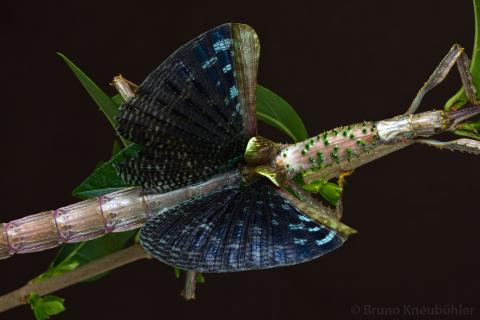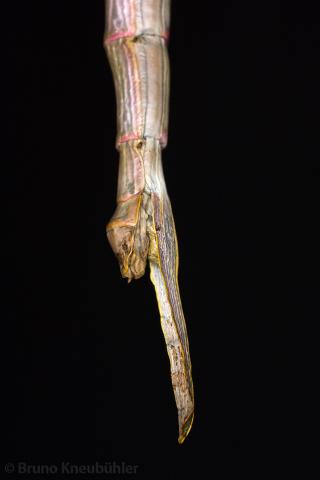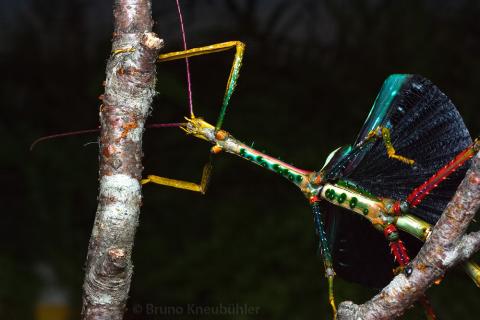
Genus
Species
Stock
CLP
316
PSG
149
Culture status
Probably lost
Foodplants
Bramble (Rubus spp.)
Salal (Gaultheria shallon)
Oak (Quercus robur)
Raspberry (Rubus idaeus)
Beech (Fagus sylvatica)
Guava (Psidium guajava)
Rose apple (Syzygium jambos)
Eucalyptus spp.
Breeding notes
(by Bruno Kneubühler)
General Notes
- described by Servielle in 1838 as Cyphocrana punctipes
- identification by Oskar Conle
- cultures of this species (all from unknown provenience) have been introduced and bred successfully over the years
_________________
Culture History
- 2009, new stock culture has been imported and successfully bred by
Bruno Kneubuhler (CH) - 2010, distributed to other breeders as Achrioptera punctipes punctipes, because at that time there were two A. punctipes subspecies
- 2019, a new phylogenetic work has revealed that the two A. punctipes subspecies are actually two distinct species. Thus A. punctipes is again the valid name for this species
_________________
Origin
- Madagascar. Unfortunately the exact provenience of this stock is unknown
_________________
Female
- very big, spiny and beautiful creatures
- about 20 - 22 cm long
- numerous big, green spines on the thorax
- spines often have a dark, almost black tip
- many spines on the legs
- basic colour are different shades of brown, with slight reddish, yellowish and pink areas
- they are winged
- membranous part of the hind wings is black with few bluish or white dots
- antennae are wine-red
- long subgenital plate, much longer than die abdominal ending
_________________
Male
- very colourful phasmids – with bright blue, red and yellow
- much smaller and thinner than the females
- about 13 to 14 cm long
- very spiny thorax (dorsally) and legs
- they have fully developed wings
- membranous part of the hind wings is black with few bluish or white dots
_________________
Nymphs
- about 22 mm long (L1)
- very short antennae
- dark brown (L1)
- even with freshly hatched nymphs it is very easy to distinguish ♀♂ by the naked eye
_________________
Eggs
- big eggs - which look very much like plant seeds
- about 9 x 4 mm
- brown or greenish-brown, with dark brown mottling
- matt
- the color of the eggs is influenced by the food plant the females are feeding on. For example eggs are greenish when the females are feeding on bramble (especially fresh ones in spring), and the eggs are brown when they are feeding on Salal
- eggs often have thin cracks, which seems to be normal and does not influence the hatching ratio
_________________
Food Plants
- the natural food plant is not known (maybe the same as for A.cliquennoisi, which is an Upacea species of the Family Phyllanthaceae
- cut away the edges of the food plants to induce feeding for nymphs in L1 and L2
- bramble (Rubus spp.)
is well accepted by freshly hatched nymphs, older nymphs and adults. But fresh leaves in spring should not be offered, as these are not accepted well. And these can cause diarrhea and thus even lead to death (especially of females) - Salal (Gaultheria shallon)
is well accepted by freshly hatched nymphs, older nymphs and adults - oak (Quercus spp.)
is well accepted by freshly hatched nymphs, older nymphs and adults - Himbeere (Rubus ideaeu)
is well accepted by freshly hatched nymphs, older nymphs and adults - beech (Fagus sylvatica)
is well accepted by freshly hatched nymphs, older nymphs and adults - Guava (Psidium guajava)
is well accepted by freshly hatched nymphs, older nymphs and adults - rose apple (Syzygium jambos)
is well accepted by freshly hatched nymphs, older nymphs and adults - Eucalyptus (different species)
is well accepted by freshly hatched nymphs, older nymphs and adults - in summer I offer bramble and beech together
_________________
Behaviour
- nymphs usually hatch in early morning, after sunrise or even at noon time
- freshly hatched nymphs are quite active and run around a lot. They settle down a short time after they have started to feed, then they also change their color to a lighter brown
- like all Achrioptera, also nymphs of A. punctipes moult by just hanging from their hind legs. During this critical time they are vulnerable against disturbances – like when their cage is overcrowed
- nymphs and adults do not like to be touched, adults then often open up their wings
- nymphs and adults are often active during the day, therefore their cage should be in a quite place (the living room or rooms with frequent loud music are certainly not the right place for them)
- when being touched both males and females often open up their wings with a loud rustling noise and try to trap the „predator“ between the spines on the hind legs (defence reaction).
- even though males are fully winged, they are just capable for a short clumsy flight downwards
_________________
Developement
- incubation time (HH-incubation on slightly damp sand at 20 - 23 °C) is about 5 – 7 months, but can also be 10 or more months
- spread some dried (!) moss over the eggs - this will make it much easier for the nymphs to hatch unscathed and it also reduces mould growth to some extend
- hatching ratio is usually quite high (> 40 %)
- but I also had generations in which the hatching ratio was rather low (about 20 %), for unknown reasons
- males will be adult after about 3 – 3.5 months (at 20 – 23°C), females after about 4 – 4.5 months
- it takes 4 – 5 weeks after the final moult until the males are fully colored
- females start laying eggs after about 3 weeks
- about 20 – 30 eggs per female and week
- it happens that few females lay almost white eggs, which have no or just little patterns. I suspect that the reason is that the food plants we can offer them in captivity is not optimal. Yet even these eggs turn brown after some time during incubation and healthy nymphs hatch too
- older females gradually lay fewer eggs
- adults can live for several months, males about 3 – 4 months and female 6 months and more
_________________
Distinguishing A. punctipes from A. cliquennoisi
- both subspecies should be kept seperatly by all means, most probably they can interbreed !
- adult males of both subspecies are very differently colored. A. punctipes males are generally much more colorful than A. cliquennoisi males
- upper abdominal side is yellow in A. punctipes and greenis-blue in A. cliquennoisi
- dots on the membranous part of the hindwings are bluish or white in females of A. punctipes and orange in females of A. cliquennoisi
- but eggs and small nymphs of both subspecies can NOT be distinguished beyond doubt !
- older nymphs of both subspecies are also differently colored. In A. punctipes they are uniformly brown, while in A. cliquennoisi they are contrasty brown-grey-black (see photo on the right)
_________________
Breeding Notes
- my general notes on how to breed phasmids are an integral part of this care sheet ...
- not the easiest phasmid species to breed, but due to its beauty certainly worth a try
- I recommend to start with at least 50 eggs, better even with 100 eggs
- as the freshly hatched nymphs are already quite big, therefore the incubation container should be big enough
- it is highly recommend to keep the nymphs seperate from the adults, which makes it much easier to monitor their developement and they are protected from being disturbed or even harmed by the much bigger adults (like during their moults)
- keep the nymphs in a cage with big ventilation areas, but take care that the humidity does not drop too low
- Achrioptera need a lot of light. If you have the opportunity, then place their cage right in front of a east-facing window with some direct morning sun. But make sure that the sun can not heat the cage up too much !
- I offer them artificial lightening with strong HDI lamps ( 2 x 150 W), which seems to be enough light for them too
- a humidity level of about 60+ % rH (for adults) and 75+ % rH (for nymphs) seems to be fine
- nymphs can be kept in a Faunabox (or similar cages like Faunarium) or even a netting cage
- move nymphs to a bigger cage as they grow bigger
- it is advantageous to spray nymphs in L1 to L3 with (chlorine-free !) water 3 - 4 times a week. But the water must completely dry up in a rather short time - at least within some hours. Therefore a really airy cage is essential, and a ventilator very advisable
- older nymphs, adults and their cage can be sprayed with water 1 - 2 times a week. But the water should dry up quickly too !
- a cage of at least 60 x 40 x 30 cm should be provided for 2 adult couples
- for a good culture one needs at least 3 cages of 60 x 40 x 30 (cm), as older nymphs should also be kept seperate from the adults
- do not keep more males than females in the same cage, as they hassle the females a lot
- a ventilator (which runs about 10 – 15 times a day for 15 minutes) should be provided too
- when the temperatures are good enough, then put them outside (in a netting cage) and offer them some direct sunlight. Just make sure that they can not overheat
- make sure that nymphs, which are about to undergo their adult moult, do not find places in the cage which would not offer them enough space beneath to moult successfully
_________________
References
- Phasmida Species Files (www.phasmida.orthoptera.org)


















